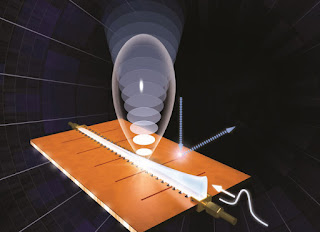Topics: Consumer Electronics, Electrical Engineering, Electromagnetism, Photovoltaics, Research
The last time I used the term, it was this post about television, posing in the right position with said rabbit ears for my parents; The Jetsons and flat screens. However, this is something old-to-new that never went away. Our WiFi, our remote controls to our televisions and in many cases, cars and key ignitions use this technology. Guglielmo Marconi was one of the giants that helped to spawn the modern age, others in their laboratories now the ages to come. Nanos Gigantium Humeris Incidentes...
A new simpler, cheaper and potentially more effective way to prevent radio antennas from picking up unwanted signals has been created by researchers in the US. With further development, the technique could also be used to help prevent thermophotovoltaic cells from re-emitting radiation they absorb – according to the team.
The laws of electromagnetism work exactly the same way if you run time in the opposite direction. One logical consequence of this is that an antenna designed to broadcast at a certain radio frequency will also be very good at absorbing radiation at that frequency. This is problematic for broadcast radio antennas, which will absorb radiation that has bounced back from surrounding objects – something that can have a negative impact on their operation. While there are ways of minimizing the effect of these echoes, they can be expensive and reduce the performance of the antenna.
Now, Andrea Alù and colleagues at the University of Texas at Austin have developed a new way of dealing with echoes. Their design is based on a traditional leaky-wave antenna, in which electromagnetic waves of certain frequencies couple to the space around the antenna and "leak out" as they travel along it. They added a series of variable capacitors called varactors to the antenna circuit. The capacitance of a varactor varies with the voltage applied to it, and this is used to adjust the operational frequency of the antenna. The researchers added a second, lower-frequency wave sent down the same antenna. This second wave does not couple to the space around the antenna and is therefore not radiated. However, the wave modulates the voltage on the varactors and therefore alters the operational frequency of the antenna while it is transmitting.
Physics World: New radio antenna avoids unwanted signals, Tim Wogan

Comments